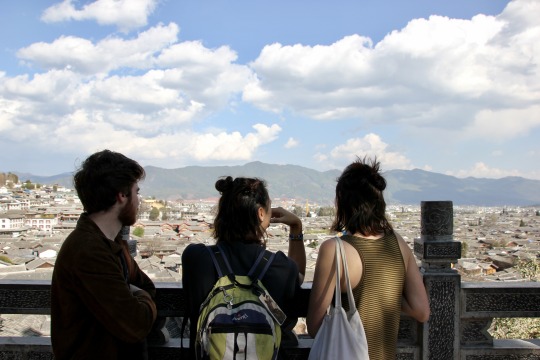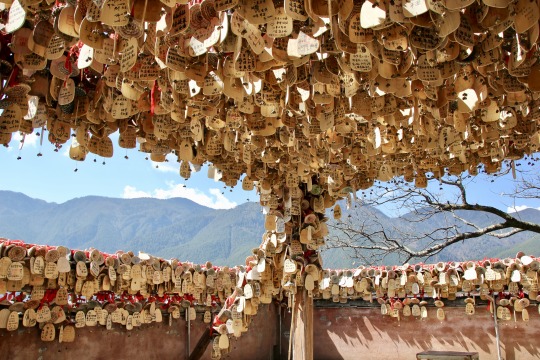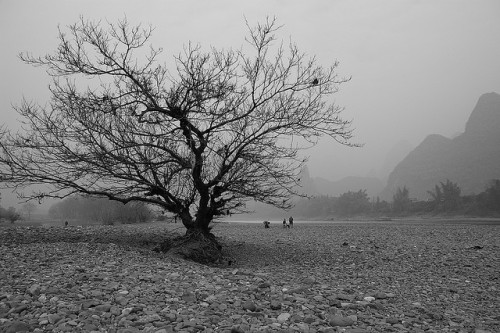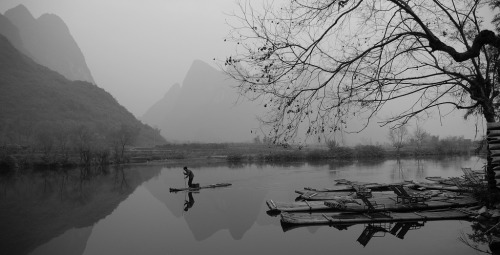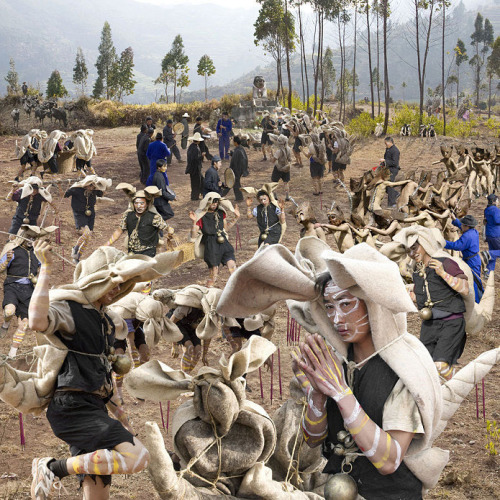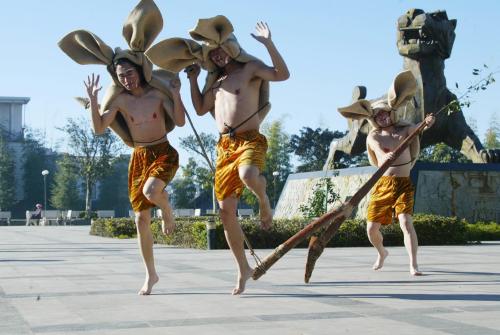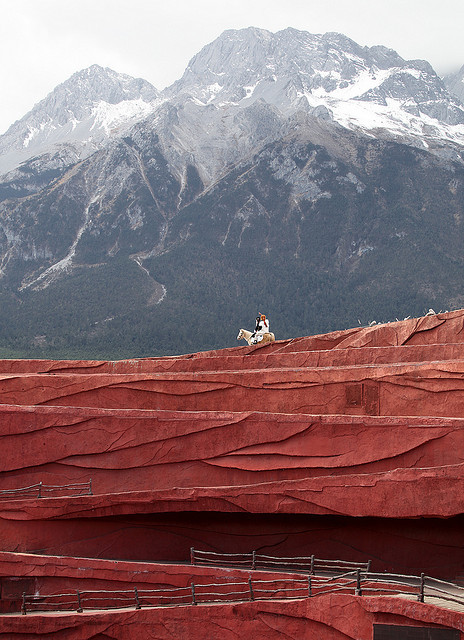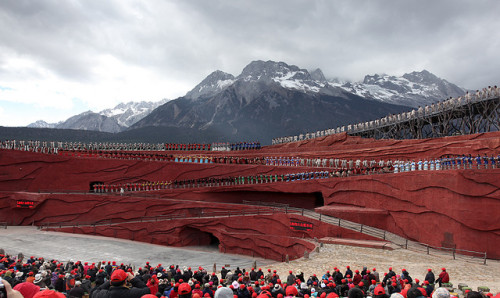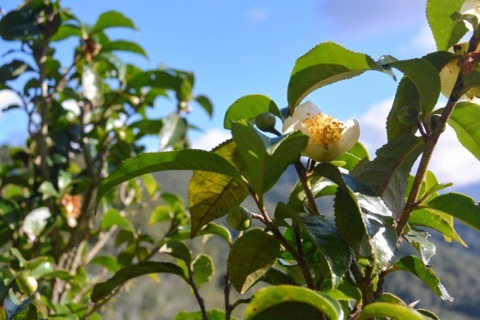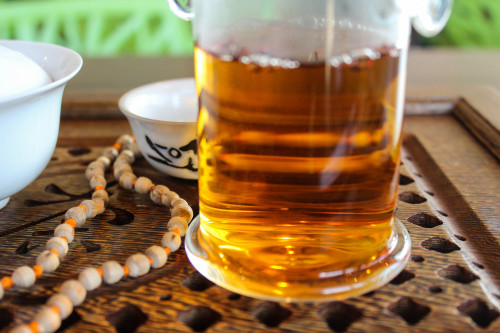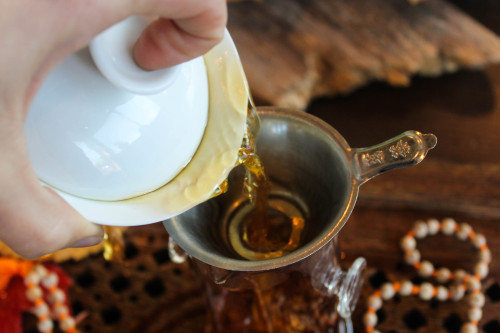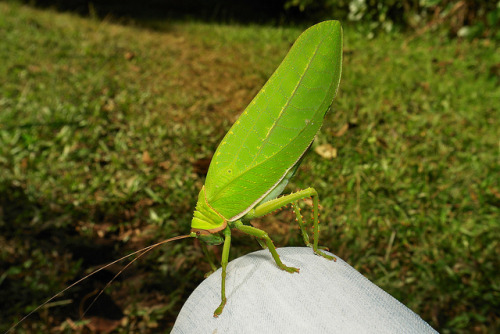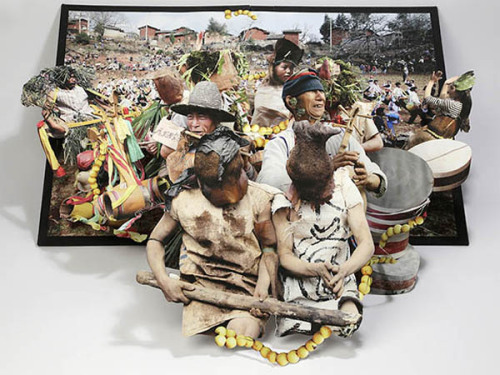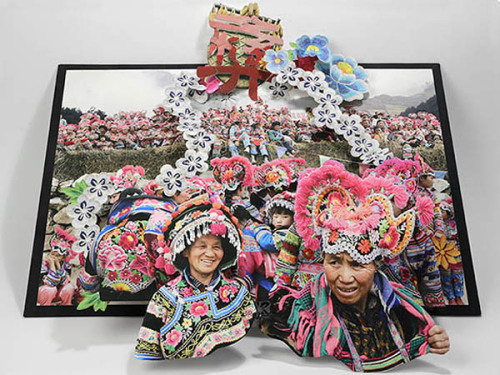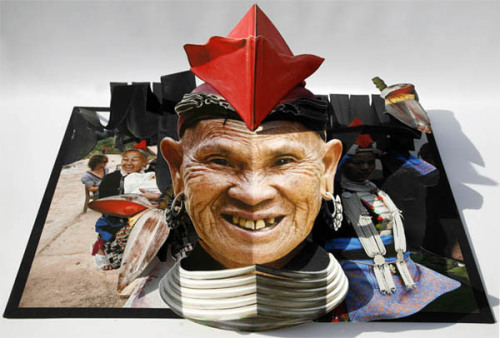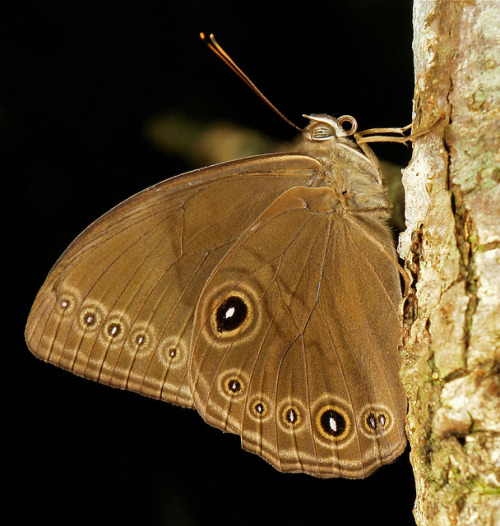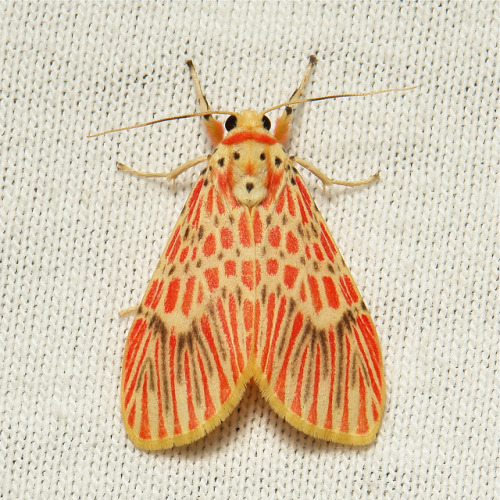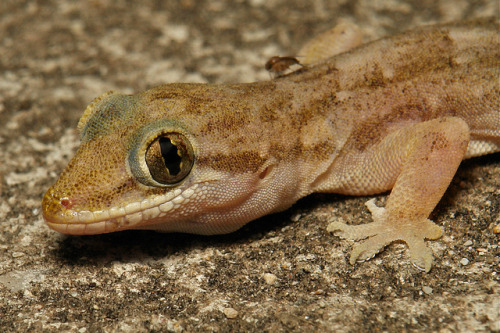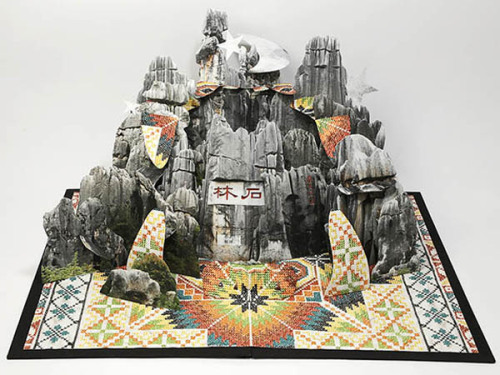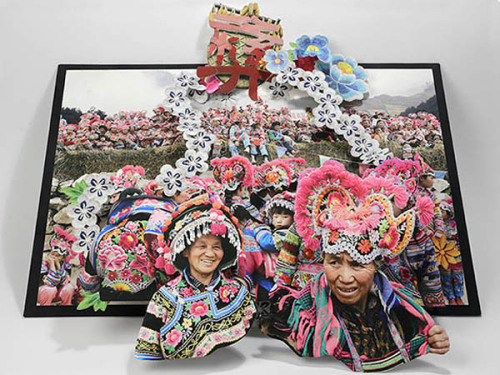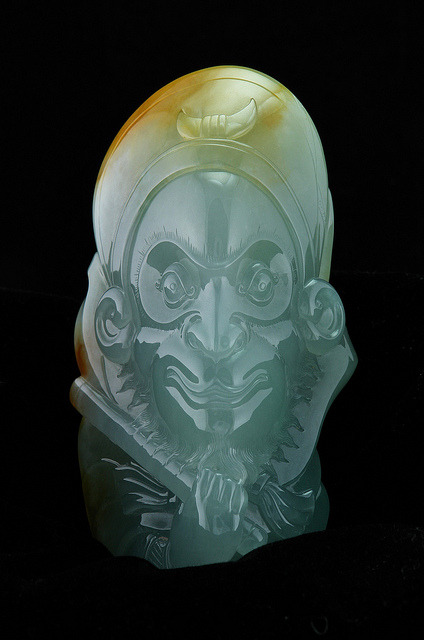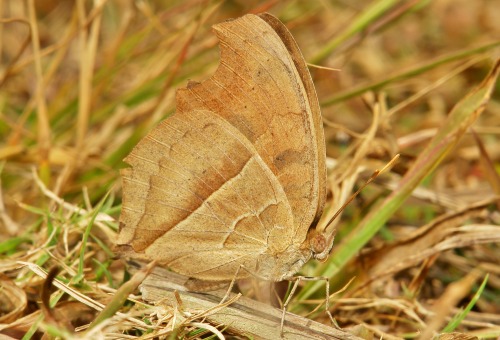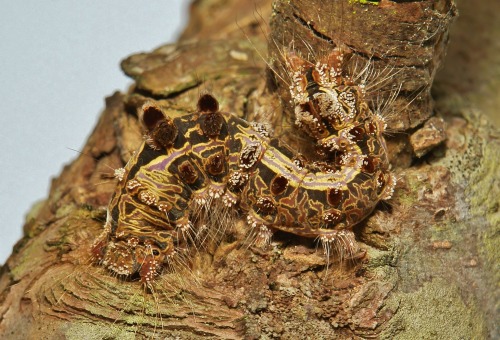#yunnan
Post link
The Tiger Dance of the Yi in Yunnan
It is said that the Yi people from Shuangbai County in Yunnan province once lived in a dense forest disturbed by snakes and wild animals. In order to prevent themselves from being hurt, they thought out a way to guard the village. Under the lead of the black Tiger King, they perform all kinds of dances reflecting the production, living, and procreation of the Yi people and go to each house at the village to help get rid of evils. Thus the Tiger Dance was created ever since, showing their tiger-like strength and valor.
Once a year, a fortnight after the Chinese Spring Festival, Wudi village stages a peculiar festival of its own - Laohuzhuan, or Dressing Up as Tigers - that in no way resembles anything culturally Chinese, unless it be the shamanistic dances of ancient, preliterate Chinese. For this event several young men don strange costumes, paint their bodies and masquerade as tigers (or leopards). They are joined by other men, including the village bimaw, in long black gowns. Together they perform magic dances to invoke the gods’ blessings for the coming rice crop.
Top illustration is a collage by Colette Fu, the other photos come from different sources. Jim Goodman has a very good description of the Tiger Dance on his blog.
Post link
Quang Minh: Impression Lijiang, 2012
Impression: Lijiang is a large-scale show composed of a series of musical performances that largely portray the life of the Naxi, Yi, and Bai peoples of the western part of Yunnan (雲南). The show takes place inside Jade Dragon Snow Mountain Park near the town of Lijiang (麗江), at an incredible elevation of 3500 metres in an outdoor theater specifically designed to showcase the mountain which is used as a backdrop.
The production itself is designed by Zhang Yimou (director of Raise the Red Lantern, Hero,House of Flying Daggers), Fan Yue and Wang Chaoge, and features a cast of over 500 people, and a more than 100 horses. It runs since 2007.
Westerners might initially be surprised by the matriarchal context of the performances – depicting the women going to work while the men laze around, get drunk and sing songs to make their women proud. It should be considered that both cultures are quite different to most others, even to that of Han Chinese culture. The Yi and Bai are a strictly matriarchal culture while the Naxi (which is officially regarded as a parent culture to both the Yi and Bai) has substantial matriarchal elements. To balance things out there are performances that depict the famous tea trading of Yunnan, which was a dangerous activity for the men of the time as it involved negotiating the infamous and treacherous mountain.
By the way: The view of the massif from the gardens at the Black Dragon Pool (Heilong Tan) in Lijiang is noted as one of China’s finest views, and part of Yulong Snow Mountain Scenic Area, a AAAAA-classified scenic area.
More of Quang Minh’s photos from Yunnan here.
Post link
Greetings from Qianjiazhai!
We are traveling across China, visiting our partner farmers and friends. Our first leg of the journey brings us to Master Han and his wild-picked pu'er and black tea.
Tea trees and tulsi grow wild on Mt. Ailao’s slopes alongside evergreens and aromatic herbs. Master Han’s workshop is three hours up the narrow, winding road - through the morning fog and onto the peak itself.
The full story is coming soon - for now, stay tuned for more photos, video and more from Qianjiazhai and the rest of our journey!
Post link
photo set: brewing up our newest harvest of Zhu Rong Yunnan Black tea
Tasting Notes: wheat, honey, toasted nuts, coriander, citrus, cedar, marshmallow
Post link

Funing, Yunnan, China, 1992
Photo: Wu Jialin
Noctuid Moth (Erebus macrops, Catocalinae)
In Chinese folklore, legend has it that moths are human souls transformed. During Qing Ming (or Tomb Sweeping Festival) the souls will take the form of flying insects like butterflies and moths, to pay the living a visit.
The hills of Pu’er are dotted with hundreds of graves, some in congregations, others you will come across out of nowhere as individuals. Until recently, it was permitted (or at least unchallenged) to choose a family burial site on a hillside with a view at your discretion. Most of these tombs comprise a monumental headstone and altar and are tended annually at Qing Ming and/or on the anniversary of the deceased’s passing - the grave is cleaned, vegetation cleared, food offerings made and gaudy reflective decorations to deter evil spirits are erected.
Here is my “supernatural” story……
On one of the walking tracks I traverse regularly, is a pair of well-tended graves; one is a single, the other contains a couple. Last summer, on each occasion I passed, these mighty Erebus moths (they are as big as my hand) were in attendance. Always one on the single grave and two on the couple’s grave (pictured), tucked away in a dark corner under the tiled eaves of the tombstones. ( I am not kidding you).
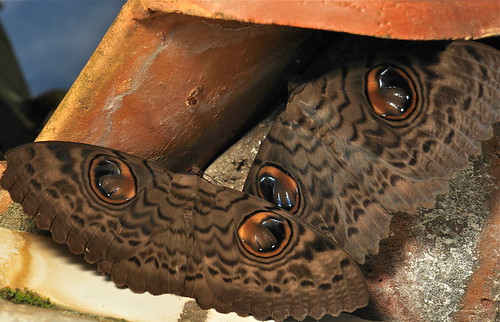
I always did my best not to disturb them as this is one “myth” I have come to respect. Occasionally though they flew away as I passed, yet obviously they returned. Presumably over the span of the summer months, these could not have been the same moths as they were invariably in pristine condition.
But regardless, it is sobering to think that the souls of the deceased are amongst us, and not too daunting to think they take the form of a noble moth.
bySinobug (itchydogimages) on Flickr.
Pu’er, Yunnan, China
See more Chinese moths on my Flickr site HERE…..
Post link
This attractive lizard inhabits various forest habitats including dry deciduous, coastal, and moist evergreen. It can be spotted on tree trunks, often low down.
Its identifying features are the single spine above each eye, and twin spines above the typanum (external ear-drum). Patterning and colouration can include various shades of brown, green and grey. Males are generally darker during the breeding season. The fingers and toes are of great length.
The Forest Crested Lizard ranges from India through Burma, southern China and Thailand to northern Peninsular Malaysia.

bySinobug (itchydogimages) on Flickr.
Pu'er, Yunnan, China
See other posts in this LIZARDS of CHINAseriesHERE.
See more images from China on my Flickr site HERE…..
Post link
Chinese Insects and Spiders
A whole heap more
Chinese Caterpillars
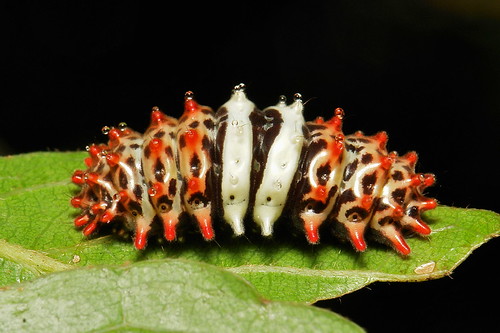
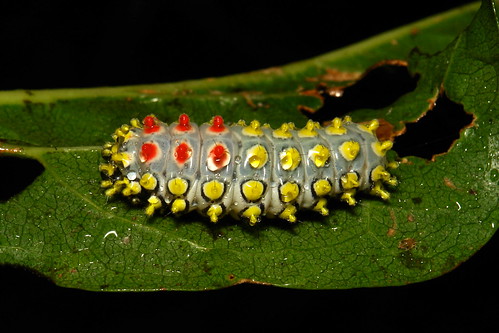

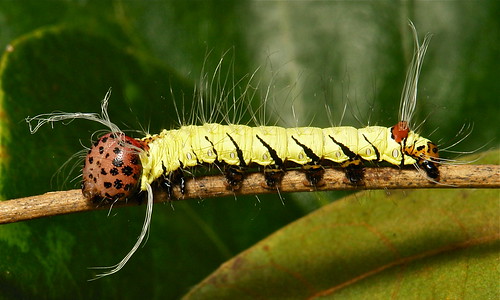
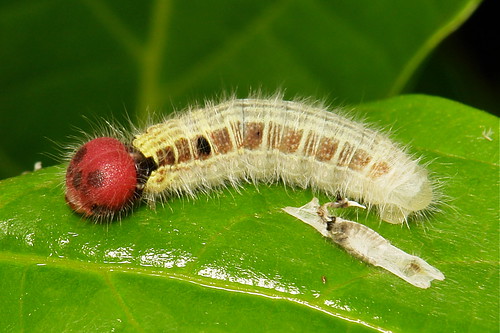
Click images to see identification (linked to their respective Flickr pages).
See others in the series of Chinese Caterpillars tumblr posts HERE.
See more Chinese caterpillars on my Flickr site HERE…..
Post link
There’s something on my knee……
Giant False Leaf Katydid (Pseudophyllus titan, Pseudophyllinae, Tettigoniidae)
If you have ever travelled or lived in China, you quickly observe that crowds form at the drop of a hat, whether it be to watch a game of chequers, minor domestic arguments, traffic accidents…and for foreigners. This happens in the big cities as much as it does in the more remote provinces, but when you are one of just a handful of 外国人(foreigners) in a third- or fourth-tier Chinese city and you are wielding a big camera with a flash diffuser AND you have China’s largest Orthopteran, P.titan (which very few Chinese people would be even aware exists), performing a threat display on your knee in the local park, the exponentially growing band of onlookers stands and stares in silent and, I will admit, unsettling curiosity.
So picture, if you will, the unseen scene in this image. I politely indicated that the crowd move aside so that I didn’t have them in the background of this shot. Behind and to the sides of me however, is a throng maybe two or three deep slowly creeping closer and closer as new arrivals at the rear of the pack push and strain to see what the commotion is.
I should have put my hat on the ground and collected some change…..
See more images of Pseudophyllus titan in my Flickr photostream HERE.
byitchydogimages on Flickr.
Pu'er, Yunnan, China
See more images from China on my Flickr site HERE…..
Post link
Chinese Insects and Spiders
…..and more
“TRUE” BUGS of China
Members of the Hemipteran suborder Heteroptera are known as “true bugs”. They have very distinctive front wings, called hemelytra, in which the basal half is leathery and the apical half is membranous. At rest, these wings cross over one another to lie flat along the insect’s back. These insects also have elongate, piercing-sucking mouthparts in which the mandibles and maxillae are long and thread-like, interlocking with one another to form a flexible feeding tube (proboscis) containing both a food channel and a salivary channel.
The immature stages of the heteropteran true bugs (nymphs) structurally resemble the adult form but are always lacking wings.
True bugs are generally well-known and include the stink bugs, assassin bugs, shield bugs, squash bugs and the aquatic water boatmen.
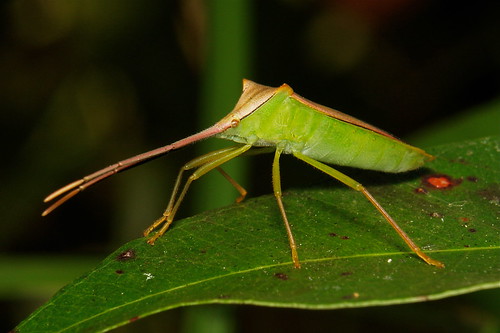

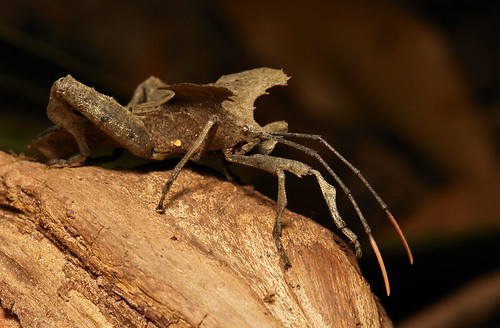

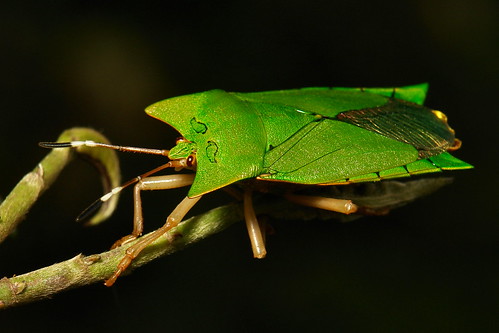
Click images to see identification (linked to their respective Flickr pages).
See others in the series of “TRUE” BUGS of China tumblr posts HERE.
bySinobug (itchydogimages) on Flickr.
Pu’er, Yunnan, China
See more Chinese true bugs and hoppers on my Flickr site HERE…..
Post link
Chinese Insects and Spiders
….more
Butterflies of China
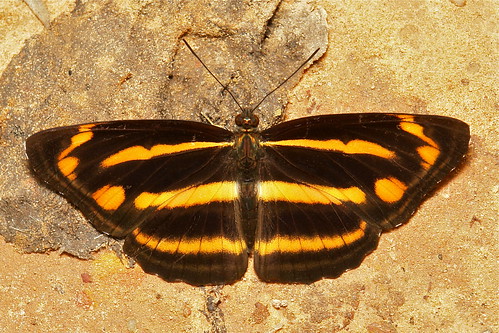
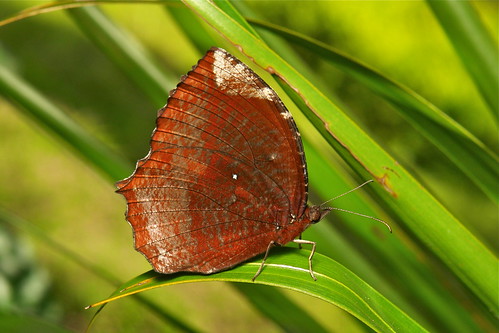
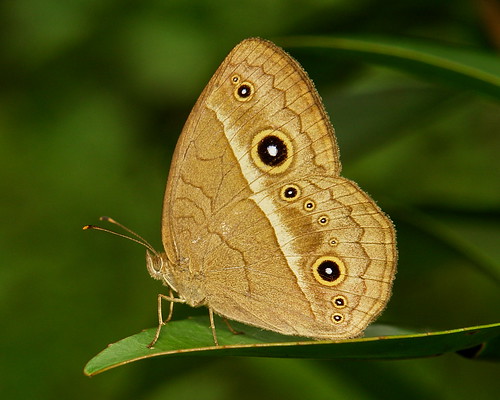

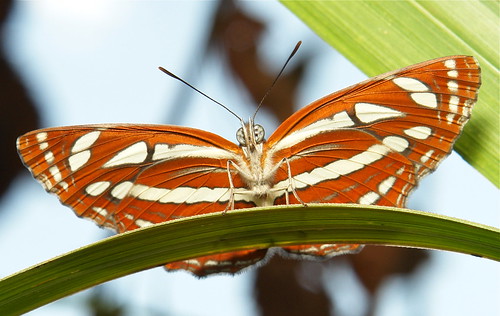
Click images to see identification (linked to their respective Flickr pages).
See my other Butterflies of China tumblr posts HERE.
See more Chinese butterflies on my Flickr site HERE…..
Post link
This is the view from the hilltop lookout over Pu’er City, Yunnan (yes the panoramic view is marred by multiple high tension electricity pylons and cables which miraculously disappear in promotional images for the city) as midnight approaches to bring in the Lunar New Year on January 31st, 2014 - The Year of the Horse. This is not a huge city by Chinese standards (a population in the surrounding district approaching 2.5 million), so I would consider this display quite impressive. Furthermore, the view into the distance is obscured by a heavy pall of smoke already in situ from the preceding hours leading up to midnight. I can never get tired of the enormity of this.
What you see is a healthy mix of tradition, male one-upmanship (“My box of fireworks is bigger than yours….oh….you have two boxes!”), a higher (probably non-disposable but increasingly disposable) income and a terrifying disregard for life, limb, property and the environment (but even I will disregard the latter in the heat of the moment).

Love it or hate it, the sheer spectacle and abuse to one’s senses of a nation igniting fireworks, both on the stroke of midnight and for the proceeding two weeks until Lantern Festival (this year on February 14th), is a sight, smell, sound, taste and emotion second to none (in my humble opinion). This is not an orchestrated “Fourth of July” display or New Year’s Eve extravaganza, this is just every man and his dog letting off steam and sulphur fumes from their front doorstep, the roadside curb, the middle of the road, parks, carparks and rooftops either pooled with their neighbors or privately, as a deterrent to bad spirits in the upcoming twelve months.
This is my seventh New Year’s period spent in China. I arrived on New Year’s Eve 2008, flying into Beijing with the city below a carpet of (mainly red I recall) sky bursts. Subsequently, I have “survived” celebrations several times now in Beijing, in Chongqing, Sichuan, and this is my third in Pu’er, Yunnan.
Rich or poor (and these pyrotechnics are not cheap by Chinese standards), first-tier city or rural village, every man and his (only) son will light at least one fuse (and likely many more) during the Spring Festival period. With all considerations for pollution, waste and hazard to person and property aside, Chinese New Year is moving, exciting and illuminating. Imagine Fourth of July, New Year’s celebrations on Sydney Harbour, an Olympic opening ceremony and the sound and light show at any major techno party ever held combined and occurring simultaneously within sight and earshot, both on the ground and high above your head, and you are still not even close…..
Happy New Year to you all…… Gong Xi Fa Cai!
byitchydogimages on Flickr.
Pu'er, Yunnan, China
See more images from China on my Flickr site HERE…..
Post link
Mid-instar Chinese Oak Silkmoth Caterpillar (Antheraea pernyi, Saturniidae)
The Chinese (Oak) Tussah Moth (or “Chinese Tasar Moth”) is originally from southern China but as it has been used for tussah silk (a wild silk) production, they have been distributed more widely across subtropical and tropical Asia.
Tussah silk is the best-known and most widely used of all the wild silks. Moths have been raised outdoors on oak trees in China for more than two millennia. The natural color of the silk is a pinkish beige but depends on the climate and soil. In the 1970s and 1980s China expanded tussah sericulture to most of its provinces, but has since abandoned these efforts in the South. Tussah is now primarily grown in the Northeast, in the provinces of Shandong, Liaoning, and Hebei. It was introduced into Japan in 1877 where it was cultivated locally on a small scale in the 20th century. Tussah silk is also raised in both Koreas.
Because it is so easy to rear, Antheraea pernyi has been used in laboratories around the world to study diapause, endocrinology, and other aspects of insect physiology.
The reeled silk has a smooth sheen like domestic silk, but the rougher spun silk is highly favored by designers of high-end fashion to make women’s and men’s suits, blazers, dresses, shirts, scarves, and other garments and accessories. Sometimes tussah is blended with cotton or synthetic fibres. Tussah silk floss is also used in quilting to make duvets.
On a more technical note, Antheraea pernyi silk has more similar sequences to spider dragline silk than the silk from its domestic counterpart, Bombyx mori. Spider dragline silk exhibits exceptional strength, toughness, and resistance to mechanical compression, properties that rival those of synthetic high-performance fibres such as Kevlar. Consequently, there is a wide spread interest in mimicking natural silks in order to produce new classes of high-performance materials and tussah silk has potential as a resource for biospinning spider dragline silk.
bySinobug (itchydogimages) on Flickr.
Pu’er, Yunnan, China
See more Chinese caterpillars on my Flickr site HERE…..
Post link
Chinese Insects and Spiders
Moths of China (Beijing and Yunnan)
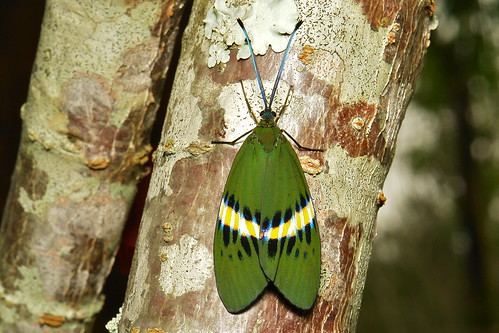
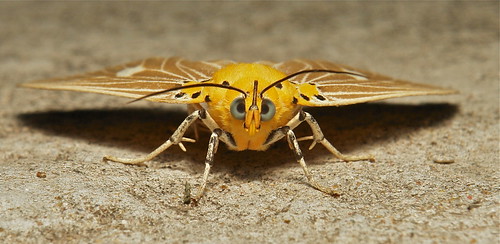
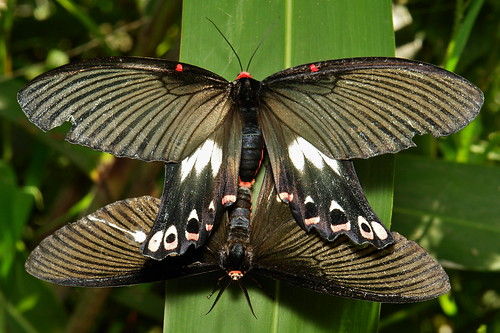

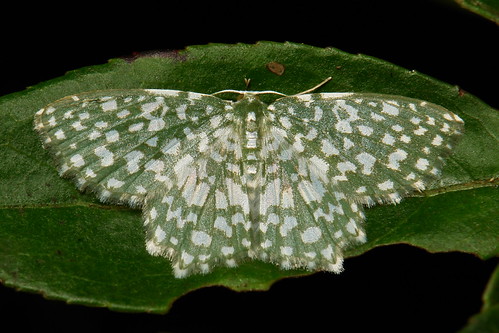
Click images to see identification (linked to their respective Flickr pages).
See my other Moths of China tumblr posts HERE.
See more Chinese moths on my Flickr site HERE…..
Post link
The Common House Gecko is a native of southeastern Asia. It is also known as the Pacific House Gecko, the Asian House Gecko, or simply, the House Lizard. Most geckos are nocturnal, hiding during the day and foraging for insects at night. They can be seen climbing walls of houses and other buildings in search of insects attracted to porch lights, hence their name “House Gecko”. Spread around the world by ships, these geckos are now common in the southern United States, large parts of tropical and sub-tropical Australia, and many other countries in South and Central America, Africa, Asia, and the Middle East.
The gecko community at my house have a pretty good life with a smorgasbord of insect life at their disposal attracted to the MV night light when I am photographing night-flyers.
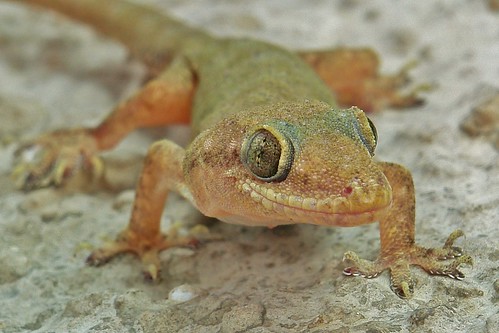
bySinobug (itchydogimages) on Flickr.
Pu'er, Yunnan, China
See other posts in this LIZARDS of CHINAseriesHERE.
See more images from China on my Flickr site HERE…..
Post link
Pop-ups by Colette Fu from her series We are Tiger Dragon People depicting the minority peoples of Yunnan province, China.
Colette Fu makes pop-up books from her photographs. She received her MFA in Fine Art Photography from the Rochester Institute of Technology in 2003 and soon after began an obsession with constructing pop-up books. Colette has designed pop-ups for award winning stop motion animation commercials and has freelanced for clients such as Vogue China, Canon Asia and Moët Hennessy • Louis Vuitton. Her work is included in the Library of Congress, the West Collection and many private and rare archive collections.
“My pop-ups are a way for me to speak, mediate, express, delight and inform. Constructing pop-ups allows me to combine intuitive design and technical acuity with my love of traveling as I try to understand the world around me. With pop-up books I want to eliminate the boundaries between book, installation, photography, craft and sculpture.”
Post link
Jade Monkey King
The Monkey King is a main character in the classical Chinese epic novel Journey to the West. In the novel, he is a monkey born from a stone who acquires supernatural powers through Taoist practices. After rebelling against heaven and being imprisoned under a mountain by the Buddha, he later accompanies the monk Xuanzang on a journey to retrieve Buddhist sutras from India.
(purchased Foshan, Guangdong, China)
byitchydogimages on Flickr.
Pu'er, Yunnan, China
See more images from China on my Flickr site HERE…..
Post link
Golden Tree Frog, Common Tree Frog, Four-lined Tree Frog, or Striped Tree Frog (Polypedates leucomystax, Rhacophoridae)
Polypedates leucomystax is widely distributed throughout South and Southeast Asia, hence it’s variety of common names. It thrives in both wetlands and forests. In urban settings, P. leucomystax can be found in garden ponds, on buildings, and on roads.
Breeding is year-round in some parts of the range but in drier areas, breeding is restricted to the start of the wet season. Males congregate at still or slow-moving water, or puddles, and call from the edges or elevated positions on vegetation. The call has been described as a “widely spaced nasal quack, and occasionally a low throaty chuckle”. Females deposit from 100-400 eggs in oval-shaped foam nests. The foam nests measure about 10 cm in length and are constructed on vegetation above ephemeral pools, or attached to a surface by the water’s edge. Hatching takes place after three to four days, occurring at the external gill stage. At this point the larvae wriggle free of the foam nest and drop into the water below. The larvae are opportunistic predators, attacking and consuming nearly anything they can, including both live and dead conspecific tadpoles and decaying vegetation. From hatching to metamorphosis takes approximately seven weeks.
bySinobug (itchydogimages) on Flickr.
Pu'er, Yunnan, China
See other posts in this CHINESE FROGS and TOADSseriesHERE.
See more images from China on my Flickr site HERE…..
Post link
The Common House Gecko is a native of southeastern Asia. It is also known as the Pacific House Gecko, the Asian House Gecko, or simply, the House Lizard. Most geckos are nocturnal, hiding during the day and foraging for insects at night. They can be seen climbing walls of houses and other buildings in search of insects attracted to porch lights, hence their name “House Gecko”. Spread around the world by ships, these geckos are now common in the southern United States, large parts of tropical and sub-tropical Australia, and many other countries in South and Central America, Africa, Asia, and the Middle East.
The gecko community at my house have a pretty good life with a smorgasbord of insect life at their disposal attracted to the MV night light when I am photographing night-flyers.
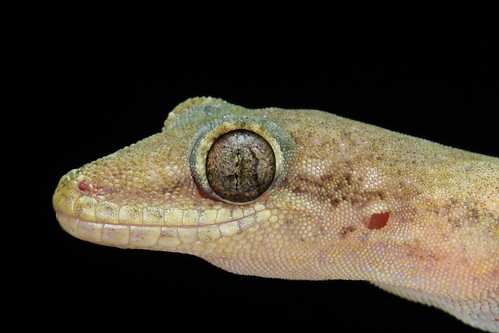
bySinobug (itchydogimages) on Flickr.
Pu'er, Yunnan, China
See other posts in this LIZARDS of CHINAseriesHERE.
See more images from China on my Flickr site HERE…..
Post link
This attractive lizard inhabits various forest habitats including dry deciduous, coastal, and moist evergreen. It can be spotted on tree trunks, often low down.
Its identifying features are the single spine above each eye, and twin spines above the typanum (external ear-drum). Patterning and colouration can include various shades of brown, green and grey. Males are generally darker during the breeding season. The fingers and toes are of great length.
The Forest Crested Lizard ranges from India through Burma, southern China and Thailand to northern Peninsular Malaysia.
Basking juvenile……

bySinobug (itchydogimages) on Flickr.
Pu'er, Yunnan, China
See other posts in this LIZARDS of CHINAseriesHERE.
See more images from China on my Flickr site HERE…..
Post link
sinobug:
Chinese Insects and Spiders
IMAGES (top to bottom), linked to their respective Flickr page:
Nolid Moth (Chloephorinae, Nolidae)
Peacock Pansy (Junonia almana), dry season form
Geometrid Moth Caterpillar (Tanaorhinus viridiluteatus, Ennominae, Geometridae)
Tussock Moth Caterpillar
Mass moth caterpillar hatching
See my other posts in the Colours in Nature Series HERE.
See more Chinese insects and spiders on my Flickr site HERE……
Post link
See more Chinese insects and spiders in SINOBUG.
sinobug:
….and more
Moths of China (Beijing and Yunnan)

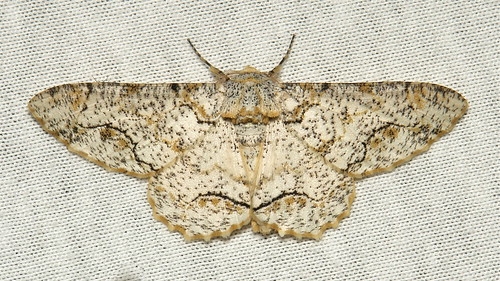
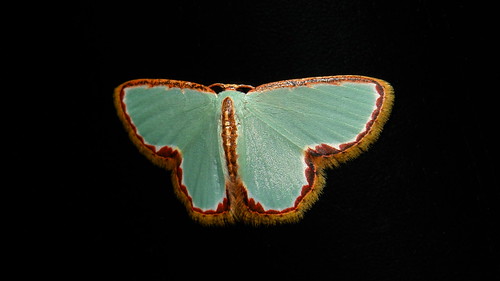

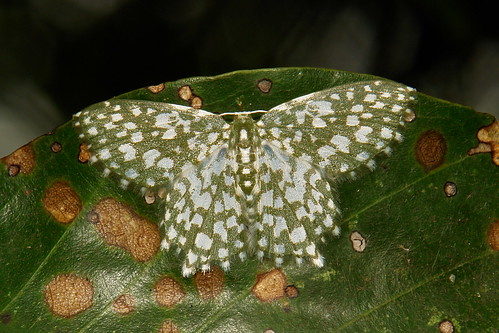
Click images to see identification (linked to their respective Flickr pages).
See my other Moths of China tumblr posts HERE.
See more Chinese moths on my Flickr site HERE…..
Post link
soldiers of the Tibetan army in Shigatse, 1938
The Tibetan Army was established in 1913 by the 13th Dalai Lama, who had fled Tibet during the 1904 British invasion of Tibet and returned only after the fall of the Qing power in Tibet in 1911. During the revolutionary turmoil, the Dalai Lama had attempted to raise a volunteer army to expel all the ethnic Chinese from Lhasa, but failed, in large part because of the opposition of pro-Chinese monks, especially from the Drepung Monastery. The Dalai Lama proceeded to raise a professional army, led by his trusted advisor Tsarong
The Tibetan Army held the dominant military strength within political Tibet from 1912, owing to Chinese weakness during the Japanese occupation of China. With the assistance of British training, it aimed to conquer territories inhabited by ethnic Tibetans but controlled by Chinese warlords, and it successfully captured western Kham from the Chinese in 1917
Tibet’s military control was located in Qamdo from 1918. During this time, the Sichuan warlords were busy fighting the Yunnan warlords, allowing the Tibetan army to defeat the Sichuan forces and conquer the region. The Tibetan Army was involved in numerous border battles against the Guomindang (KMT) and Ma Clique forces of the Republic of China. In 1932, the KMT defeated the Tibetan army, driving them out of Kham.
Their first encounter with the People’s Liberation Army was in 1950, when they took over Dengo, and after failed negotiations initiated the Battle of Qamdo, marking the Chinese occupation of Tibet that continues to this day.
Post link
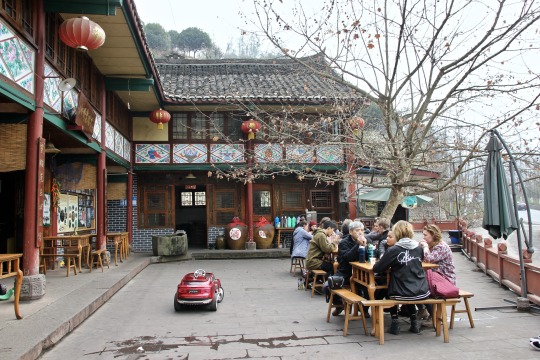
I was sitting in a noodle restaurant in Shanghai, one Saturday before we were set to leave for this legendary trip when I started coughing. It’s no big deal, I reasoned, these peanut butter noodles are spicy and there’s pollen in the air and plenty of smog, so surely the tickle in my throat is only that, nothing sinister. We live in a fair world, so there’s no way I could get a cold right before the amazing trip to the Yunnan and Sichuan provinces I’ve heard so much about.
It was a nasty cold, and I was banished from the trip.
I spend a week and a half alone, healing slowly, drinking buckets of water, and dreaming of the adventures my classmates were having. I was healed when they returned, and I eagerly cornered them and demanded stories. I began with Kate and Emma, shoving my phone in their face as we waited for our noodles.
Kate Yachuk: We talked to Professor Wang, I think, and he told us about the last living hieroglyphic language in the world, which is spoken by thirty people, of which he is one. He was one of the Yi people, he was super friendly and very knowledgeable. And he brought us to his house and gave us lots of candy!
Now, ask any Tom, Dick, or Harry, they’ll tell you how much I love candy, but what I love even more is linguistics. It drives my friends insane, but I’m proud of how truly nerdy I am. One of the main, nerdiest reasons I was so gung-ho for this particular field trip was to personally observe the culture of the Mosuo people, one of the last matriarchal society in the world, with whom I have been fascinated since I was ten years old. The Mosuo live around Lugu Lake, and Emma gave me the briefest of fill-ins on the matter.


Emma Barker: So, since we had to turn around and not go to the Tibetan village, we had to pull some strings, I think. We were going to the Lugu Lake anyway, but we had extra time from the change of plans, and Liu Wei said he had a friend nearby. We went and visited her house and talked about her culture and then we visited a monastery. We walked around there and were shown around by some monks and a living Buddha. Then we went back to this lady’s house and she wanted to dress us up in some traditional clothing; first we dressed up Zack and Samudra, then we roped Lyric and Liu Wei into doing it too. Everybody looked really good!

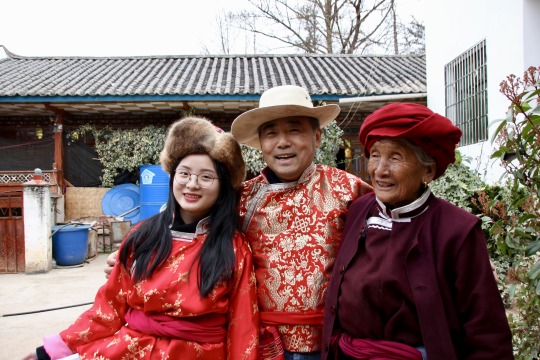

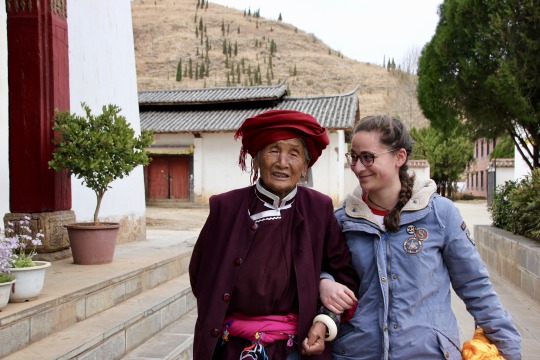
Jealous as I was hearing of Emma’s adventures, I continued to seek stories of the trip. I knew, from years ofGlobal Collegefield trips, that the programming frequently outshone the way it was described on our itinerary, like the way the performance in Taiwan was explained to us as mere children’s theater. Sophie confirmed my beliefs.
Sophie Gagnaire: So, on the trip we met this Naxi woman and she took us to a monastery where her brother works, where we met the living Buddha. I was really blown away by how decadent and extravagant it was. The monastery was in this compound that also had a four-hundred-year-old building, so we got to see these original wall paintings from four hundred years ago, and this massive, thirty- or forty-foot Buddha statue. It was amazing!
One of these things that most clearly marks aGlobal College field trip is the last-minute adjustments. It is not that Global is unprepared; quite the opposite, in fact. It is rather than a field trip of this nature, twenty foreign students attempting to experience something meaningful in the same place, year to year, lends itself to mishaps and unexpected schedule adjustments, and Global is admirable in the way in which it adapts to such itinerary shifts, and the way in which its students learn to adapt and participate.
Santiago Sanchez y Lucero: So, we drove seven hours into the mountains to make it to the Tibetan region [of Yunnan province], and about six hours in, we ran into police officers who told us that we had to turn back because we were arriving on the tenth anniversary of an uprising that was orchestrated by American student. We seemed like a suspicious group, which I guess is fair.
I caught up with Nicole after I spoke to Santi, asking if they ever did come into contact with Tibetan culture. We were all, at least in our late-night pre-trip debates, keen to engage with Tibetan culture, given that this may be our only chance. We are, after all, a crew of liberal arts students from the United States filled with radical ideas and a truly American inability to censor ourselves when it is appropriate.
Nicole Price: I forget which day in the trip this was, but it was a few days into our trip, and we visited a university where they have an entire portion dedicated to Tibetan language and culture. We got to see their archives of Tibetan language and culture, and also other minority languages that have almost died out, like the Yi language. It was really cool because we got to enjoy a perspective, through these archives, that not a lot of people would have access to. It was exciting to see in practice the things we had been learning about all semester.
Now, Global field trips are, first and foremost, about learning; after all, we wouldn’t be going into this much debt for a degree if we weren’t being provided an excellent education. Still, I spent most of my childhood at summer camp, and I have noticed some close similarities between a day at camp and a day on a Global field trip. Many similarities are superficial, such as the odd sleep schedule, unusual group activities, and the way you seem to fit more into one day that you would fit outside of camp/field trip in a week. What stands out the most, though, are the ability you develop to adapt, at lightning speed, to adversity, and the degree to which you bond at dinner time. At camp, social life revolves around the dining hall, and in the mountains with your Global classmates, you feel the most like a wonderful family when you’re swapping food and stories and recounting your day over more food that you could ever finish. Courtney-Lynn agreed wholeheartedly.
Courtney-Lynn Mellina: My favorite group dinner from the Yunnan trip was the Tibetan-style dinner we had with the living Buddha and the rest of the class. It was, by far, one of my favorite dinners in all of Global, and the food was spectacular! I made some new Tibetan friends, we had great conversation and I tried foods I had never tried before It was a real sense of community that I’m so glad I was a part of.
Now, in spite of certain commonalities, every trip is different. I love taking the things we learned in the classroom out into the field, and I know many of my classmates feel the same. It’s always exciting to find a new way of learning, exploring areas made accessible to you only by the luck of going on the trip; I hope my jealousy isn’t coming through in my writing, I’m not bitter, I’m fine, everything is fine. Sophia and I caught up over dumplings.
Sophia Cox-Wright: One of the highlights, definitely for me, going on this trip would be that, because of scheduling matters and some things, logistically, that just ended up not working out, which kind of just happens sometimes on Global trips, we got a bit more time to just hang out and be alone. It gives you a chance to just learn from the place that you’re in. For example, one of the things that I really enjoyed was going in to the town square in one of the villages and just sitting there and watching the tourist trade and Chinese tourists. It was interesting seeing the effects of it, if that makes sense, and seeing it for myself instead of just reading, trying to integrate myself into that space. That experience is definitely something I’m going to be thinking about for a while.
As I gathered these stories, both for the purposes of writing and personal gratification, I couldn’t help but compare them to the looks on my classmates’ faces when they returned and my own past experiences. This trip to Yunnan and Sichuan provinces was as intense an experience as promised, and like any field trip, the best and the worst part was coming home. After all that you learn, you just want to be somewhere comfortable to process it, even if that means leaving beautiful new places you have become attached to. By taking part in the post-trip emotional processes of my friends, I enjoyed the trip in my own way: vicariously. Until I have time to visit on my own, that will have to be enough.
by Julia McCoy.

